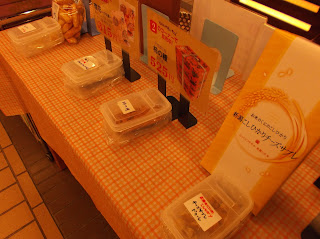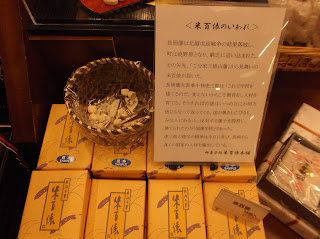I returned to Gangi Dori. Gangi means covered alley. Dori means street.
がんぎどおりに戻りました。がんぎ(雁木)とはcovered alley、どおり(通り)とはstreetのことです。
I found "Shoyu no Mi" (lit. soy sauce mash) produced in Nagano.
長野県産の「しょう油の実」を見つけました。
I bought one bag, hoping that this would be a good one. (Some shoyu no mi products taste just awful.)
いい商品だと期待して1袋買いました(ひどい味のしょう油の実もあります)。
Kogomi (fiddleheads) and tara no me:
こごみとたらの芽:
Koshiabura:
こしあぶら:
Hakurei take (dake?):
ハクレイ茸(たけ、だけ?):
This is new to me. Similar to eryngii.
初めて見ました。エリンギに似ています。
Dried zenmai:
干しぜんまい:
Udo:
うど:
Dried enoki:
乾燥えのき:
Dried enoki has become quite popular these days.
乾燥えのき(干しえのき)は最近かなり一般的になりました。
Asparagus roots:
アスパラの根:
Just like Ponshukan, Gangi Dori is also very generous with their free samples.
ぽんしゅ館同様、がんぎどおりも試食をいっぱい出してくれます。
I bought some hegi soba.
へぎそばを買いました。
Kanzuri:
かんずり:
Karinto and karinto-like sweet made of pasta:
かりんとうとパスタでできたかりんとうのようなお菓子:
Koshihikari rice produced in Nishiyama (lit. western mountains) in Shiozawa:
塩沢西山産のコシヒカリ:
Nishiyama is famous for producing the very best Koshihikari rice.
西山は最高のコシヒカリの産地として有名です。
Pickled nozawana:
野沢菜漬け:
Left: Wasabi-flavored, right: regular
左:わさび風味、右:通常
Left: Fukinoto miso, right: Nanban miso (spicy miso)
左:ふきのとう味噌、右:南蛮味噌
Komako Mochi:
駒子もち:
Ika meshi:
いかめし:
Squid stuffed with rice.
ご飯が入ったイカです。
You can see Funaguchi from Kikusui (top right), which I posted about recently.
最近紹介した菊水のふなぐち(右上)が見えます。
Yukiguni Renga (lit. Snow Country Bricks):
雪國れんが:
Sake chocolate brownie.
酒チョコレートブラウニーです。
Pork jery:
ぶたジャーキー:
Ichigo choco daifuku:
いちごチョコ大福:
Ichigo = Strawberry, choco = chocolate.
Free samples:
試食:
It was hard for me to leave Gangi Dori, but I had to because I had another destination. On my way to the bus stop, I found an ekiben stall.
「がんぎどおり」からは離れがたかったのですが、別の目的地があったので、離れました。バス停に行く途中、駅弁の売店がありました。
The top of the ekiben popularity ranking at this stall is ikura tarako meshi (rice with salmon roe and cod roe).
この売店の駅弁人気ランキングのトップは、いくらたらこめしです。
(To be continued.)
(続く。)

































10 comments:
Hiroyuki, I think I would never leave Gangi Dori ;-) So many incredible things to taste... (I would love to taste the spicy miso and the stuffed squid, sake chocolate brownie for example).
I have just had a thought... I have never seen clients' favourite ratings in any shop or restaurant in Europe. (It's so clever! I have already seen it on Kodoku no Gourmet). When you go to a restaurant in European countries, the only thing you might find is "chef recommends" dishes and it is always a list of the most expensive dishes... Typical!
Sissi: If I had been rich, I would have bought the oyakonabe, beer cup, and dozens of other things...
I would also have bought lots and lots. Hard to resist, there are so many interesting things (spicy miso..). I love to visit those kind of market streets in other countries. All these dried or preserved goods are wonderful for tourists - nice souvenirs (canned sake...).
This client rating is interesting. Here chefs recommendation should not be taken that seriously. Most of the time they have overdated goods and try to sell those quickly - therefore I would never eat the todays fish dish due to chefs recommendation, or it is expensive.
Yuzu salt: It is quite easy to make your own spicy salt, just grind the lemon or orange peel and mix with salt. Works with all different kind of herbs, even rose or violet petals too (some have to be dried a little before mixed with salt). Very good for fish is a mix of lemon peel grind, chopped thyme and crushed black pepper salt. They sell these spiced up salts for big money.
Haha, I see that Kiki has the same experience in restaurants as me ;-)
Kiki and Sissi: It's very interesting that you two have made similar comments about ratings and today's or chef's recommendations.
I would be willing to order today's recommendations because I assume that the restaurant has succeeded in purchasing certain ingredients cheap on that day and is willing to offer them at reasonable prices. I guess things are much different between Japan and Europe.
Hiroyuki, I wasn't talking about today's recommendations. These are really a great deal in many French restaurants for example because they mean that these are dishes which are not on the menu usually, but the chef had a seasonal inspiration at the market...
I was talking (and Kiki too I guess) about lots of restaurants where on the menu there is a page with "chef's recommendations", they never change and always cost at least 30% more than the majority of dishes. It's just to attract the client to the more expensive dishes. It's practically here in every Chinese, Thai and Indian restaurant I went to and always expensive.
Haha! And if restaurants buy some products cheaper they will never sell them cheaper in Europe! They will always think "great! I will have a bigger % of gains today". You do understand now why we are so charmed and amazed by the Japanese honesty and respect towards the client....
Sissi: Thank you for correcting me. Hmm.... I will never understand what the restaurant business is like in your country and Kiki's unless I actually visit there and see it for myself...
Hiroyuki, I think it's similar in whole Europe... There are exceptions of course, but when one arrives to Japan one of the most striking sides of the restaurant business is the honesty and respect towards the client. I suppose that Germany, France and Switzerland are far from being the worst from this point of view in Europe...
Sissi: Thanks again! your comment reminds me of the saying: Honesty pays in the long run.
Customers are no fools, right? They won't come back to a restaurant that looks suspicious.
Post a Comment